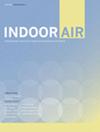Ammonia Cycling and Emerging Inorganic Secondary Aerosols from Arable Agriculture
IF 4.3
2区 环境科学与生态学
Q1 CONSTRUCTION & BUILDING TECHNOLOGY
引用次数: 0
Abstract
Air quality monitoring in Ireland is under the jurisdiction of the Environmental Protection Agency in compliance with the Gothenburg Protocol, EU/national legislation, and the National Clean Air Strategy. Secondary inorganic aerosols (SIAS) have been acknowledged as a key atmospheric pollutant, with serious public health impacts and no safe exposure threshold in place to date. Ammonia (NH3) emissions are linked to the secondary production of aerosols through atmospheric reactions occurring with acidic atmospheric components such as sulfuric, nitric, and hydrochloric acid. These reactions result in the formation of ammonium sulfate, ammonium nitrate and ammonium chloride, among others. Approximately 98% of NH3 emissions occurring in Ireland arise from agriculture, with minor contributions from transport and natural sources. A better understanding of NH3 emissions and SIA formation can be achieved through monitoring emissions at the source level. Additionally, mitigation strategies with a more thorough understanding of NH3 dynamics at the source level and consequential SIA formation allow for more efficient action. This project monitored ambient NH3 and SIA on two selected arable agricultural sites and a control site in a rural site close to Dublin on the east coast of Ireland to establish emission levels. Meteorological factors affecting emissions and SIA formation were also measured and cross-correlated to determine micro-meteorological effects. Monitoring at the agricultural sites observed ambient NH3 concentrations ranging from 0.52 µg m−3 to 1.70 µg m−3, with an average of 1.45 µg m−3. At the control site, ambient NH3 measured concentrations ranged from 0.05 µg m−3 to 1.76 µg m−3 with an average of 0.516 µg m−3. Aerosol NH4+ ranged from 0.03 µg m−3 to 1.05 µg m−3 with an average concentration of 0.27 µg m−3 at the agricultural site. The potential effects of meteorological conditions and the implications for the effects of these emissions are discussed, with recommendations to aid compliance with the National Emissions Ceiling and the National Clean Air Strategy (Directive 2001/81/EC).氨循环和新兴的农业无机二次气溶胶
根据《哥德堡议定书》、欧盟/国家立法和《国家清洁空气战略》,爱尔兰的空气质量监测由环境保护局管辖。二次无机气溶胶(SIAS)已被公认为一种关键的大气污染物,具有严重的公共卫生影响,迄今尚无安全接触阈值。氨(NH3)排放与通过与硫酸、硝酸和盐酸等酸性大气组分发生大气反应而产生的气溶胶的二次生成有关。这些反应产生硫酸铵、硝酸铵和氯化铵等。爱尔兰大约98%的NH3排放来自农业,交通和自然来源的贡献较小。通过监测源水平的排放,可以更好地了解NH3的排放和SIA的形成。此外,通过更全面地了解源级NH3动态和相应的SIA形成,可以采取更有效的减缓策略。该项目监测了两个选定的农业耕地和爱尔兰东海岸都柏林附近农村地区的一个控制地点的环境NH3和SIA,以确定排放水平。还测量了影响排放和SIA形成的气象因子,并相互关联以确定微气象效应。在农业站点监测到的环境NH3浓度范围为0.52µg m - 3至1.70µg m - 3,平均为1.45µg m - 3。在对照组,测得的环境NH3浓度范围为0.05µg m−3 ~ 1.76µg m−3,平均值为0.516µg m−3。气溶胶NH4+浓度范围为0.03 ~ 1.05µg m−3,平均浓度为0.27µg m−3。讨论了气象条件的潜在影响以及这些排放的影响,并提出了有助于遵守国家排放上限和国家清洁空气战略(指令2001/81/EC)的建议。
本文章由计算机程序翻译,如有差异,请以英文原文为准。
求助全文
约1分钟内获得全文
求助全文
来源期刊

Indoor air
环境科学-工程:环境
CiteScore
10.80
自引率
10.30%
发文量
175
审稿时长
3 months
期刊介绍:
The quality of the environment within buildings is a topic of major importance for public health.
Indoor Air provides a location for reporting original research results in the broad area defined by the indoor environment of non-industrial buildings. An international journal with multidisciplinary content, Indoor Air publishes papers reflecting the broad categories of interest in this field: health effects; thermal comfort; monitoring and modelling; source characterization; ventilation and other environmental control techniques.
The research results present the basic information to allow designers, building owners, and operators to provide a healthy and comfortable environment for building occupants, as well as giving medical practitioners information on how to deal with illnesses related to the indoor environment.
 求助内容:
求助内容: 应助结果提醒方式:
应助结果提醒方式:


